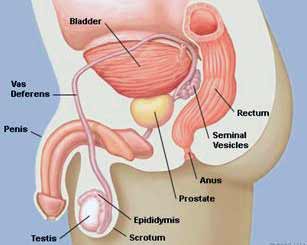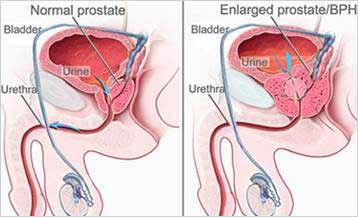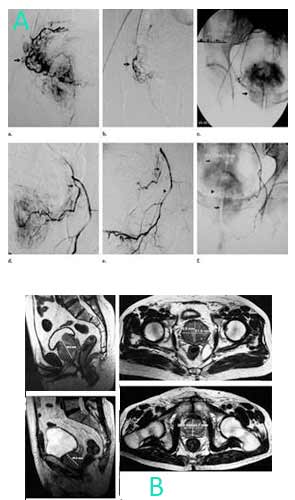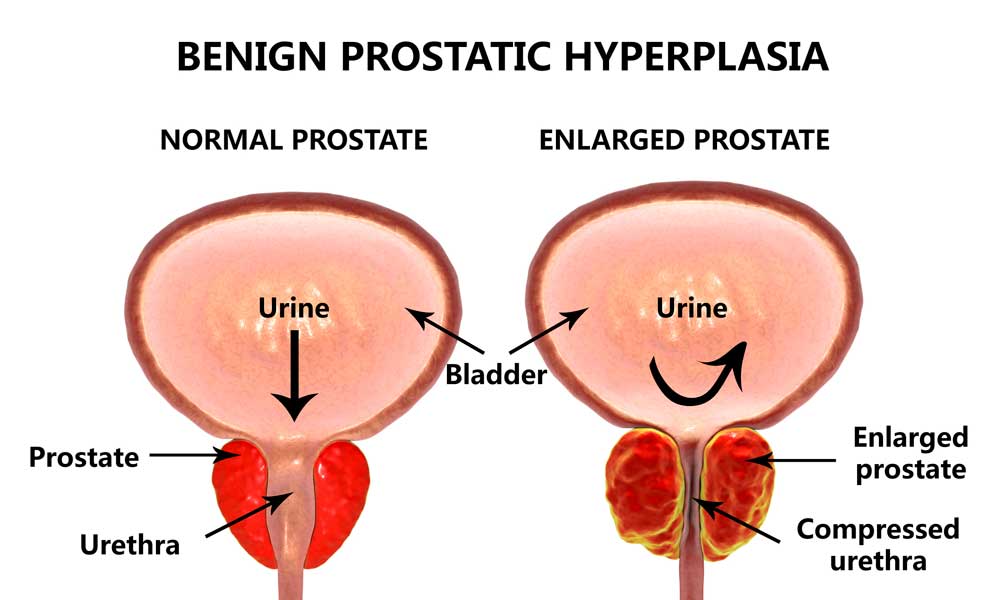Enlarged Prostate (Benign Prostatic Hyperplasia – BPH)
The prostate is a small, walnut-sized gland located between the bladder and the male organ.
It is located directly in front of the rectum, with the urethra running through its middle to carry urine from the urinary bladder to the outside.
This prostate gland has a vital role in male reproductive health by secreting a fluid that nourishes and protects sperm. At the time of ejaculation, the prostate contracts, pushing this fluid into the urethra, where it combines with sperm to form semen.
The vasa deferential (singular: vas deferens) bring sperm from the testes to the duct of seminal vesicles. The seminal vesicles contribute fluid to semen during ejaculation.
As a man ages, there is a good chance that he will develop an enlarged prostate or benign prostatic hyperplasia (BPH). In fact, it is estimated that close to 80% of men will develop BPH. More than 40% of men who develop an enlarged prostate will need treatment to correct symptoms from this enlarged prostate.
Symptoms & Causes of Enlarged Prostate (BPH)
- A weak or slow urinary stream
- A feeling of incomplete bladder emptying
- Difficulty in starting urination
- Frequent urination
- Urgency to urinate
- Getting up frequently at night to urinate
- A urinary stream that starts and stops
- Straining to urinate
- Continued dribbling of urine
- Returning to urinate again minutes after finishing
When the urinary bladder is not able to empty fully, it increases the risk of infections. Other serious problems can also develop over time, including bladder stones, blood in the urine, incontinence, and acute urinary retention (inability to urinate). A sudden and complete inability to urinate is a medical emergency; you should see your doctor immediately. If not treated, BPH can occasionally cause harm to the urinary bladder / kidneys.
The prostate keeps enlarging as a man ages. In most men, this enlargement is to an extent that leads to urinary symptoms or urinary obstruction. The prostate enlargement is not completely understood, but it is thought to be linked with changes in the sex hormone balance as men grow older.
Risk factor of Enlarged Prostate (BPH)
- Aging Prostate gland enlargement rarely causes signs and symptoms in men younger than 40. By 55, about 1 in 4 men have some signs and symptoms. By 75, about half of men report some symptoms.
- Family history. Having a blood relative such as a father or brother with prostate problems means you’re more likely to have problems as well.
- Where are you from? It is more commonly seen in the men of the United States and Australia, whereas it is less prevalent in Chinese, Indian, and Japanese men.
Test diagnosis of Enlarged Prostate (BPH)
- Detailed questions about your symptoms.
- Digital rectal exam. This exam can determine whether your prostate is enlarged or not.
- Urine test (urinalysis). It can help rule out an infection or other conditions that can cause similar symptoms.
- Prostate-specific antigen (PSA) blood test. It is a type of protein that is secreted by the prostate that liquefies the semen. However, PSA levels can also be elevated due to prostate cancer, recent tests, surgery or infection in the prostate.
- Urinary flow test. This test measures the strength and amount of your urine flow.
- Post-void residual volume test. Tests measure how completely your bladder is emptied, and frequently by using ultrasound to quantify residual urine.
- Transrectal ultrasound. An ultrasound test provides measurements of your prostate and also reveals the particular anatomy of your prostate.
- Prostate biopsy. With this procedure, a transrectal ultrasound guides needle to take tissue samples of the prostate. Examining tissues from a biopsy under a microscope can help diagnose or rule out prostate cancer.
- Urodynamic studies and pressure flow studies. A catheter threaded through ureathra in to the bladder and a fluid slowley injected to know bladder pressure and the functioning of the muscles.
Prostate cancer is entirely different than prostate gland enlargement, even though they can cause some similar symptoms and may be detected by some of the same tests. Having an enlarged prostate doesn’t reduce or increase the risk of prostate cancer. Even if you’re being treated for an enlarged prostate gland, you still need to continue regular prostate exams to screen for cancer.
Surgical Treatment Options for Benign Prostatic Hyperplasia (BPH)
There are many treatment options. Many men experience no signs or symptoms of an enlarged prostate. In these situations, watchful waiting, which is monitoring without treatment, could be an optimal strategy. Enlarged prostates aren’t cancerous.
- Transurethral resection of the prostate (TURP)
- Open prostatectomy
- Laser surgery
Transurethral Resection of the Prostate (TURP)
TURP has been a common procedure for enlarged prostate for many years, and it is the surgery with which other treatments are compared. With TURP, a surgeon places a special lighted scope (resectoscope) into your urethra and uses small cutting tools to remove all but the outer part of the prostate (prostate resection). In most of the men, symptoms are quickly relieves after TURP, with normal urine flow being reported soon after the procedure.
Limitations: TURP could only be performed on prostates that are 60 cubic centimetres in size or less.
Complications
- Risk of heavy bleeding even few days after surgery.
- Infection
- You may temporarily require a catheter to drain your bladder after the procedure.
- You’ll be able to do only light activity until you’re healed to reduce the chances of bleeding.
- Erectile dysfunction.
- Water intoxication.
- Urinary incontinence.
Open Prostatectomy
This type of surgery is generally done if you have a very large prostate, bladder damage or other complicating factors, such as bladder stones. It’s called open because the surgeon makes an incision in your lower abdomen to reach the prostate. Open prostatectomy is the most effective treatment for men with severe prostate enlargement, but it has a high risk of side effects and complications. It generally requires a few days stay in the hospital and is associated with a higher risk of blood transfusion.
Laser Surgery
Laser surgery (also called laser therapy) uses high-energy laser to destroy or remove overgrown prostatic tissue. Laser surgery generally relieve symptoms right away and have a lower risk of side effects than does TURP. Laser surgery is also used in men who can’t have other prostate procedures because they are taking blood-thinning medications.
Side effects are common in any of these prostate surgeries, such as semen flowing backward into the bladder instead of out through the penis during ejaculation (retrograde ejaculation), loss of bladder control (incontinence) and impotence (erectile dysfunction).
Non-surgical treatment – Prostatic Artery Embolization(PAE)

Picture A: – Angiographic picture in a 74-year-old patient with urinary retention with a bladder catheter. Before and after Prostatic Artery Embolization. Picture B: – Pelvic MR images in a 78-year-old patient with BPH. Before PAE shows an enlarged prostate diameter of 59.2 mm and a prostate volume of 95.5 m. After 6 months of PAE shows significant reduction in size.
Now a new procedure has been developed that is comparable to TURP in recovery of the symptoms with no side effect. It is called Prostatic Artery Embolization or PAE.
The patients are admitted to the hospital on the day of the procedure after all basic investigations. During embolization procedure, pain medication, anti-inflammatory drugs and antibiotic are given.
Embolization is performed under local anaesthesia by femoral artery access, usually by the right femoral artery and pelvic angiography is performed to understand prostatic artery. then a 5F angiography cather is advanced in the prostatic artery, through cathter a 3 F microcatheter coaxially introduced to reach opening of prostatic artery. For embolization PVA particles are used to stop abnormal supply to enlarged prostate The procedure is carried out with blockage of arterial supply. Once both prostatic arteries are embolized, the catheter is removed. Within 4–6 hours, patients can walk around without a urinary catheter. Normal daily activities can typically be resumed on the same day.
Advantages of Prostatic Artery Embolization ( PAE)
- PAE can be performed on any size of enlarged prostate.
- It does not produce the side effects/complications that TURP does.
- No blood loss or risk of blood transfusion.
- No ugly surgical scars. Whole procedure is done through a small nick around the skin in the groin region.
- Makes for faster recovery and early activity
- No Need of hospital stay. it is done on day care basis or one-day hospitalization.
- Most men experience no pain to light pain and leave the hospital in a day after intervention.
- No Side effect of loss of bladder control (incontinence)
- No sexual dysfunction following prostatic artery embolization like retrograde ejaculation and impotence (erectile dysfunction). Quarter of patient report that sexual function improved after the procedure.
- PAE procedure need no general anesthesia. It needs just mild sedation.
- It is cheaper than surgery.
- Overall success rate is about more than 98%.
Best Treatment Solution – Non surgical treatment – Prostatic Artery Embolization
Prostatic Artery Embolization (PAE) is a procedure done by an interventional radiologist. The procedure is not a surgical intervention and allows all the functions of prostate to be kept in place. After embolization the shrinkage of an enlarged prostate occurs in 2-3 weeks time.
Why PAE is the best option
- PAE can be performed on any size of enlarged prostate.
- It does not produce the side effects/complications that TURP does.
- Whole procedure is done through a small nick around the skin in the groin region.
- Most men experience no pain to light pain and leave the hospital in a day after intervention.
- No sexual dysfunction following prostatic artery embolization.
- Quarter of patient report that sexual function improved after the procedure.
- PAE procedure need no general anesthesia It needs just mild sedation,
- No blood loss or risk of blood transfusion.
- No surgical ugly scars and makes for faster recovery.
- It is cheaper than surgery.
- Overall success rate is about more than 98%.
